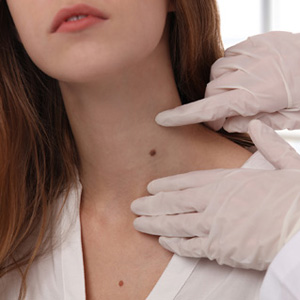When it comes to moles, there are certain guidelines that we use to alert us to potential abnormalities. As a result, most people expect “normal” moles to appear perfectly round and symmetrical and of a particular color. There are exceptions, however, to the general rules about diagnosing and treating moles. Atypical moles, in particular, can be confusing for many of our Huntington, NY patients.

An atypical mole is formally referred to as a dysplastic nevus. It is a type of acquired mole, meaning it is not present at birth. Different from typical moles, the dysplastic nevus is unusual in its appearance. It does not adhere to the rules of “ABCDE” from the time it first appears, causing undue concern for many people who notice this type of growth.
Dysplastic nevi may be oddly colored, may be quite large, uneven, and even asymmetrical. They may have smooth, defined borders or borders that are highly irregular. They may be flat or raised and may have several of these characteristics all at once. When viewed with the naked eye, the atypical mole may look quite similar to malignant melanoma. Their differences lie within individual cells and within the particular arrangement of cells in a mole.
Examining an atypical mole
There is good reason to examine tissue from an atypical mole closely. By taking a biopsy, a small sample of tissue, we are able to examine the cytology, or individual cells of the growth. Additionally, we can see the way cells in the mole are relating to one another, and grade the mole from mild to severe in terms of it abnormality.
The significance of an atypical mole
The general guideline is that a single atypical mole is only mildly concerning. More attention is required in situations when dozens of these moles exist. Statistics demonstrate that there is a higher risk of melanoma in a person with numerous atypical moles, especially if melanoma “runs in the family.” At the same time, there can be a family history of dysplastic nevi, as well.
Skin cancer and its correlation to moles on the face and body is an area of medicine that continues to advance. We encourage patients to remain consistent with annual skin cancer screenings and monthly self-examination and to talk with us about how to decrease the risk of skin cancer through adequate sun protection.
Schedule your skin cancer screening today at (631) 417-3300.









